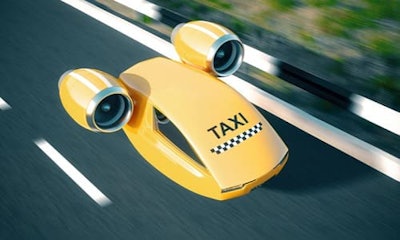
By Jeff Sanford
Toronto, Ontario — July 27, 2018 — In this week’s AV Report: The first-in-history Congressional hearing on flying taxis, Intact floats ‘real-time’ insurance pricing, Waymo chief tells governors AVs will launch later than expected, and much, much more!
The LA Times notes that, “… a meeting of the House Committee on Science, Space, and Technology — billed as the first congressional hearing dedicated to the topic of flying cars by Chairman Lamar Smith (R-Texas) — made clear that urban flying vehicles will pose a new set of challenges beyond the autonomous vehicles that are being tested on city streets across the United States.” According to Smith, “Traffic and gridlock challenges are better overcome by cars that fly, rather than drive. Although it will be a while before we see widespread ownership and use of personal vehicles that can both be driven and flown, these advances are visible on the horizon.” According to the article, “… industry representatives at the hearing were executives from ride-hailing company Uber and Terrafugia… [plan] to release [a] flying car next year at a price tag of $400,000. Both companies aim to operate services that would eventually allow people to be picked up by an autonomous flying taxi and transported to their destination.” There are those pesky technical issues, however. Safe flying taxis require developing systems that can, “… learn from and adapt to situations never before encountered.” That challenge “is one of the biggest,” according to a source in the story, John-Paul Clarke, a College of Engineering dean’s professor at the Georgia Institute of Technology and co-chair of a 2014 National Research Council committee on autonomy research for civil aviation. “But I don’t think it’s insurmountable,” he said. He estimated the necessary degree of sophisticated technology is still five to 10 years out. That would be, “to the level where I would feel comfortable getting on an airplane.” Community input on vehicle noise levels also needs to be gauged. Some early versions of these things are so ridiculously loud they are nowhere near practical. https://lat.ms/2NP04A5
This past week, Microsoft made changes to the boilerplate language contained in the “Forward-Looking Statements” section of its latest securities filing. Companies are required by law to disclose real risks that could affect business in that section. The new language is around artificial intelligence and the Internet of things. According to Microsoft the new risks include the “development of the Internet of things,” which presents, “… security, privacy, and execution risks.” As well, issues around the use of, “… artificial intelligence in our offerings that may result in competitive harm, legal liability, or reputation harm; and damage to our reputation or our brands that may harm our business and operating results.” That is, Microsoft’s lawyers realize a wave of disruption as a result of AI and the Internet of things, and no one is really sure how these shifts are going to play out. As these new technologies are released into the culture it’s impossible to say who will be harmed and what lawsuits will be filed, but it’s clear Microsoft lawyers are warning investors this technological evolution is underway.
Last week in this space a discussion appeared about some of the things that might occur in the insurance industry. This week, another company began to discuss what is possible in the world of AVs. This is an interesting conversation. According to the press release, “Early on at Voyage, we realized there would be a dramatic shift in the risk profile associated with operating a large fleet of AVs. That need led Intact Financial to partner with Uber and Turo to develop a custom ride- and car-sharing insurance product for Canada. According to an executive, “… the next step in insurance premiums is to allow them to be adjusted in real-time as people drive. Environmental factors can be taken into account. Insurance premiums could be adjusted dynamically — automatically lowering when driving in an empty parking lot, and readjusting on a busy street with pedestrians.” According to the press release, “Our vehicles already construct and record a 360-degree view of the world, so sharing that data directly with Intact felt like a natural way of developing activity and risk profiles of our operating environments. A snippet of our high-definition map. aspects of dynamic insurance pricing can be done before autonomous vehicles even hit the road, using our high-definition maps. We know before the car starts moving if a route will include any specific obstacles, and whether or not the economics of taking a slightly longer route that only includes simpler roadway makes sense. This can be optimized to reduce operating expenses of the autonomous fleet while ensuring safety for all passengers, pedestrians, and other drivers on the road.” https://bit.ly/2NLtLBV
In Phoenix Arizona Waymo is expanding its self-driving car program by targeting the customers of Walmart. Here’s a picture of a Waymo pick-up lane at tk. According to a media report, “If you already rely on ride sharing services to run errands or grab groceries, a self-driving car that shuttles you to pick up your pre-bagged tailgate party snacks may sound like a no-brainer. And that’s essentially what Waymo is up to.” https://bit.ly/2OcHYsN
Talking at the recent National Governors Association meeting John Krafcik, CEO, Waymo, told state politicians the “time period will be longer than you think” for automated vehicles to be “everywhere.” Interestingly, Krafcik, pushed back against optimistic estimates on deployment. He also pointed out that the retail market will be the last car market to have AV systems and that, “There are no autonomous systems available, zero on the road today. Anything you can buy on the road today is a driver assist system, that means the driver is completely responsible for the car and I think there is so much confusion on that. We still have to be completely alert and in control of the cars that were driving every minute, every second that we’re on the road driving.” Waymo’s fleet of Chrysler Pacifica hybrids accumulate 25,000 miles a day on the road. The Windsor-built trucks have racked up more than 8 million miles across 25 cities. Despite the rapid accumulation of testing miles, however, Krafcik warned the governors, “… not to end all of their infrastructure investments just yet.” Responding to a question about the need for new parking facilities, he said, “…there will be a very long period of overlap between personally owned human-driven vehicles and shared automated vehicles.” He did say, however,,“… it might be possible to slow down on some massive parking structures.” He also pointed out that virtual driver system on, “… cars for retail sale is going to be some time yet. The emphasis for now is the ride-hailing service, trucking and logistics, and working with transit authorities. Supplying systems for personal use cars is last on the timeline.” Interesting. https://bit.ly/2JVrKkn
The U.S. government research agency that gave us the internet and DARPA, has now given the U.S. Navy the world’s first fully autonomous warship, Sea Hunter, a submarine hunting, “… drone ship that can cross the open seas without a human crew for months at a time.” According to a press report, it has just been “officially handed over” to the Office of Naval Research, which is now “fine tuning” the drone’s autonomous features. https://bit.ly/2NNvUx3





















